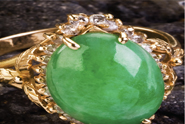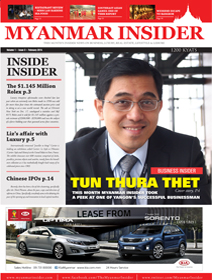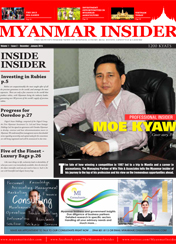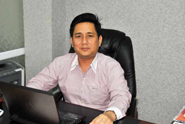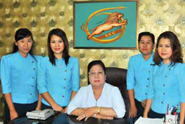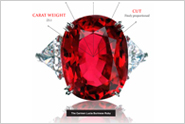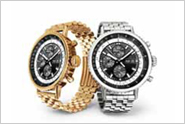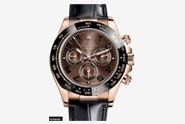The construction industry has always been looked upon as the domain of the male of the species. This month, the Myanmar Insider interviews the dynamic Daw Hla Waddy, who took charge of a family building project and developed it into a major construction business.
Name: Daw Hla Waddy
Age: 65
Main Companies: New Step Services Co.
(Distributor of New Chinthe Concrete Brand)
Square Power Group Co. (Cement Factory)
Depawaddy Co. (Construction and Property
Development)
Profession: Businesswoman
Vice President of the Myanmar Women
Entrepreneurs’ Association (MWEA)
MI: When did you start your first business in Myanmar, and is it still operational today? If so, how has the business model changed from when you first started?
DHW: In 1987, I tied up with a contractor to build apartments over the land that I owned in Yangon. After the 1988 student’s demonstrations, the contractor ran off and I was left with a half completed property without a roof over my head. I had no choice but to take charge and complete the construction on my own. I took everyone from labour leaders to painters to engineers as my teachers and tried to learn as much as I could. After the building was completed, people liked the workmanship and I was asked to develop my relative’s and neighbour’s plots. That was how I got into business. It was really boom time for property development from 1990 and 1995 and I managed to develop many properties as I earned the trust of more and more people. The business continues today and still bear the original name “Depawaddy”. In terms of changes to the business model, the ratio of split between land owner and builder has changed somewhat; in the 90s, it was 60:40 in favour of the contractor builder. Nowadays it is more like 50:50.
MI: What made you decide to diversify your business interests?
DHW: In 1987, I tied up with a contractor to build apartments over the land that I owned in Yangon. After the 1988 student’s demonstrations, the contractor ran off and I was left with a half completed property without a roof over my head. I had no choice but to take charge and complete the construction on my own. I took everyone from labour leaders to painters to engineers as my teachers and tried to learn as much as I could. After the building was completed, people liked the workmanship and I was asked to develop my relative’s and neighbour’s plots. That was how I got into business. It was really boom time for property the upgrading of skill sets, knowledge and technology. For example, a Japanese group who want to build a concrete factory in the new Thilawa Industrial Zone want to JV with me. They are asking for ISO certification, which I currently do not have. I am therefore restructuring my companies at present to catch up to international levels and standards.
MI: Hypothetically, if you were entering into business for the first time in Myanmar, what type of business would you consider as having the most growth potential?
DHW: Since I do not know much business outside the construction sector, I do not think I am qualified to answer that. I would of course recommend the construction sector, due to the number of infrastructure projects sponsored by government alone. In terms of margins, construction and property development development from 1990 and 1995 and I managed to develop many properties as I earned the trust of more and more people. The business continues today and still bear the original name “Depawaddy”. In terms of changes to the business model, the ratio of split between land owner and builder has changed somewhat; in the 90s, it was 60:40 in favour of the contractor builder. Nowadays it is more like 50:50.
MI: What made you decide to diversify your business interests?
DHW: In 1998, I was engaged as a contractor to construct most of the FMI City; Yoma Bank neighbourhood centre, sports club and more than 300 bungalows. In around 2000, there was a serious economic crisis in Myanmar, with uncontrollable inflation, as well as a banking crisis. The construction industry was in recession and I was in serious debts, as the prices I agreed with FMI for construction were now falling below the cost of my materials. It’s like a famous Myanmar proverb, “Twat Yay Taw – Sat Tha Htay, Twat Kyi Taw – Sat Ma Shi”, which means “At the time of planning, I was a rich factory owner, by the time of the actual audit, I did not even own the machines”. In 2004, I was offered the position of Managing Director at Chinthe Concrete, a company controlled by SPA (Serge Pun and Associates), a related company of FMI. When the five year investment license was completed for Chinthe Concrete in 2009, the company was voluntarily liquidated. I was offered to buy over the assets of the company at revalued book values. That was how I ended up from being a contractor developer to the owner of New Step Services Co Ltd (New Chinthe Concrete). Eventually, I ended up providing one stop service in the construction industry, from piling concrete to construction. If you had lived in Myanmar during the past 20 years, you would also have learned how to take opportunities as they come along. Government policies at that time were haphazard; I called it “elephant ear government economic policies” – opening and shutting certain things at regular intervals.
MI: Do you see any of your main business interests having to change or adapt to Myanmar’s new trends and its opening up to international markets?
DHW: As Myanmar opens up, we have more foreign investors coming in and we are also subject to more competition. My businesses need international partners to replace and upgrade old machines and capital injections to compete with international players. We directly benefited from the government opening up the country; the market demand for our products and services has increased tremendously and our sales have also grown significantly for the past two years.
MI: With the benefit of hindsight, would you have done anything differently when you started your first business, and if so, why?
DHW: Business wise, I would not have done anything differently. From a personal perspective, I wish I had taken up further studies that would help me run my businesses more effectively. Both my parents are farmers from the Irrawaddy Division and I was the first ever to graduate from our village. I was therefore content with a basic degree at that time.
MI: How do you feel that foreign companies now entering into business here will affect the local workforce, and do you feel that they will bring new opportunities to existing local businesses?
DHW: Yes, entry by international players has pushed up salaries and demand for skilled personnel. Myanmar is already facing a skill shortage, even prior to their entries. At the same time, most of the businesswomen at the MWEA had the foresight to see this coming a couple of years ago. As such, we have discussed and implemented various methods to keep our skilled staff. For myself, my companies set aside ten percent of yearly profits for our staff. We also provide housing benefits, which staff appreciate, as rentals are high and space is a premium in Yangon. In addition, we also paid volume based bonuses depending on our factory production volume. All in all, it’s both good and bad for local businesses; some who have the capacity to serve or tie up with foreigners would benefit, and those who do not will be left worse off. The capacity to tie up, in turn, is dependent on the track record of the companies.
MI: From a business perspective, what do you feel are the biggest challenges facing you in the next one to three years?
DHW: I felt the biggest challenge would be the upgrading of skill sets, knowledge and technology. For example, a Japanese group who want to build a concrete factory in the new Thilawa Industrial Zone want to JV with me. They are asking for ISO certification, which I currently do not have. I am therefore restructuring my companies at present to catch up to international levels and standards.
MI: Hypothetically, if you were entering into business for the first time in Myanmar, what type of business would you consider as having the most growth potential?
DHW: Since I do not know much business outside the construction sector, I do not think I am qualified to answer that. I would of course recommend the construction sector, due to the number of infrastructure projects sponsored by government alone. In terms of margins, construction and property development typically have margins of around 40 percent, whereas concrete production and selling only earns me like 25 percent in a good year.
MI: How do you see Myanmar comparing with its Asian neighbors in the short and long term future?
DHW: The earliest that we can be on par with some of our neighbours is ten years. It depends on the policies of the government. The government has to implement policies that encourage business growth both in the short term and long term. Businesses, in turn, will drive the economic growth. MI: If you could make one major change in the country for any of your business ventures, what would it be?
DHW: The banking system and funding for the SMEs. Currently it’s extremely difficult to raise funds for ventures. All borrowings are based on collaterals. There is no such thing as project financing yet, so I really hope that there will be more funding available for SMEs undertaking projects.
MI: What advice would you give to someone looking to start up a business and invest in Myanmar?
DHW: I believe most foreign investors are adopting a “wait and see” approach to investment in Myanmar. I have met up with many; we meet, we greet, we show them around and they go home. I think they are waiting to ensure that there will be no changes in government policies after 2015. One piece of advice would be, “No risks, no returns”. If you want everything to be ready and stable in Myanmar, you cannot expect to see high returns.
MI: In addition to running your own business, you have also acted as the head of the Myanmar Women’s Entrepreneur Association. How do you ended up being in that position?
DHW: In 1995, Professor Daw Yi Yi Myint, head of the Yangon Institute of Economics then, wanted to start the MWEA. She saw an article about me being the only prominent woman in the construction industry in DANA magazine and invited me to join to be part of an initial gang of 30. I was the MWEA joint secretary for eight years, and secretary for another eight before I assumed the current position of vice president.
MI: Can you briefly explain the activities of the MWEA?
DHW: The MWEA is open for all active businesswomen or women who are involved in business education. Our main objective is to develop female entrepreneurs. We provide extremely useful networking sessions; new members can showcase their wares and market their products through monthly gatherings. We also provide development courses during these events.
MI: How does the MWEA encourage more women to become entrepreneurs?
DHW: We provide monthly talks, we provide guidance to those women in need. We also realise the importance of education for women. We have done a survey which shows that families are generally poorer if the women in the family are uneducated. As such, we sponsor girls for primary education for five years. We started that programme (“Foster Mothers”) in 2004 and more than 400 poor and underprivileged girls have benefited from this. We also provide special loans to fund promising ventures from villages and/or farmers. To support the government’s initiative to lower poverty across the country, we have also began providing micro loans to some female staff of the MWEA members.
MI: As a female entrepreneur running such a big enterprise, how do you manage to balance work and family?
DHW: As women, we have to display many fronts. For husbands, we have to take care of them, sometimes sweet talk to them and put them in front of us. These little efforts will count a lot towards getting their unwavering support. For children, love and affection are a must. There is always a supportive husband behind every single successful female entrepreneur.
MI: What would be your advice for aspiring female entrepreneurs?
DHW: With Myanmar opening up, there are bound to be plenty of opportunities available. As such, I would caution them to be more goal focused and to take on limited challenges. Do not do everything, and everyone has bandwidth!

